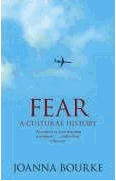Fear: A cultural history
 |
Author: Joanna Bourke |
This book is not for the fearful. It doesn't offer solutions and is not a self help guide for people who are full of fear. What it offers is a fascinating guide to what people have been getting frightened of from the 19th century right up to current times, how we have dealt with these fears and how widespread they have been.
You may be surprised to learn that during the late 19th and early 20th centuries fear of being buried alive was widespread. Why would people be worried about that? People had little faith in the doctor's capacity to assess accurately or truthfully whether a person was 'really' dead. Joanna Bourke abundantly illustrates the grip of such fears with real life accounts and anecdotes. We learn of the 'British Association for the prevention of premature burial' and the healthy trade in 'coffins with alarms' should the unfortunate (or fortunate?) prematurely interred person suddenly awaken inside the tomb.
The author writes about the frightening world of the child, and child care advice though the ages which veered from exposing the child to as many fears as possible to shielding the infant from every possible threat (health and safety, anyone?). Nightmares offer a rich seam of fears and terrors, and although the psychology is a little dated now - Freudian analysis is mentioned a fair bit - it all makes for fascinating reading.
Drawing on the work of such famous psychological writers as Gustave Le Bon, we hear about crowd responses to disasters, from the Iroquois Theatre fire in Chicago in 1903 (in which six hundred people were killed amidst the panic) to the Bethnal Green air raid shelter disaster in London in 1943 (in which hundreds were crushed to death even though there was no air raid). Bourke examines public contemporary reactions to these events, bringing them vividly alive, making them feel current and illustrating how perceptions of threat have changed.
We learn about frontline soldiers in both world wars, blitzed Londoners, and the new 'invisible' threats of the nuclear cold war in which we were suddenly aware that war could be 'everywhere' - and apocalyptic. Health problems are always going to be a good source of fear. Cancer has long been a leader in the health fear field, but why were doctors advised never to mention 'the c word' to women sufferers? Are women inherently less able to face this threat than men? (History shows otherwise!) The AIDS hysteria of the late 1980s is examined, a time when policeman wore protective gloves during gay rights marches in case they had to make arrests. Throughout the book we read extant accounts from the experience of ordinary people, which helps keep it all real and personal.
The 'stranger danger' of the 1990s is discussed, the time when the most likely source of threat to children was an unknown male (although again history shows otherwise), and children in general were thought to be in danger from such attentions. This hadn't even figured as a social threat in the 19th and for much of the 20th century.
And of course the 'terrorist threat' is dissected. Terrorism is such a catch-all term and like AIDS or cancer can seem to be 'invisible' and vague until it is too late. After the 2001 September 11th atrocity in America, one thousand 'Arab looking' US citizens were assaulted, and six were killed. Politicians used fear and 'terrorism' to misdirect the public over scrutiny of foreign policy, argues Bourke.
She also explores how the 9/11 massacre seemed so instantly familiar to people, as if 'life was imitating art' (or at least horror movies). One survivor said: 'It was like a movie set! I was watching people die for the first time. But I knew what they looked like because I'd grown up seeing those things (in movies). Everything looked like what I'd seen before.' (p. 361)
The author also discusses heroism and the strange calm that overcomes those who find themselves facing inescapable annihilation. We know about this from the accounts of those for whom (it turned out) the annihilation was not inescapable, such as some World War II fighter pilots.
This is a great book that may not diminish any fears you have but will definitely get you thinking about them from a wider perspective.








